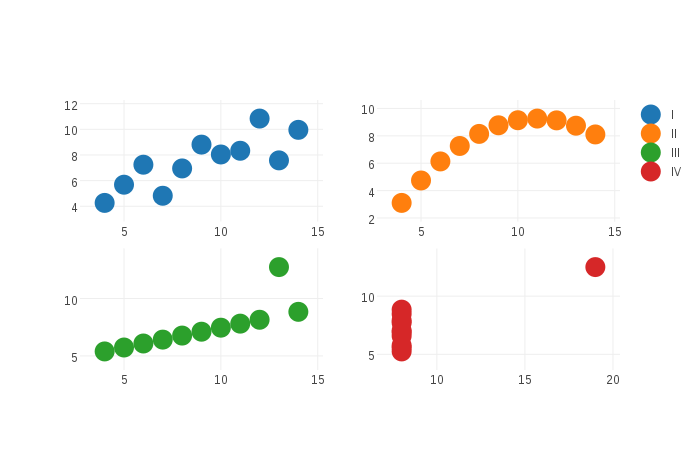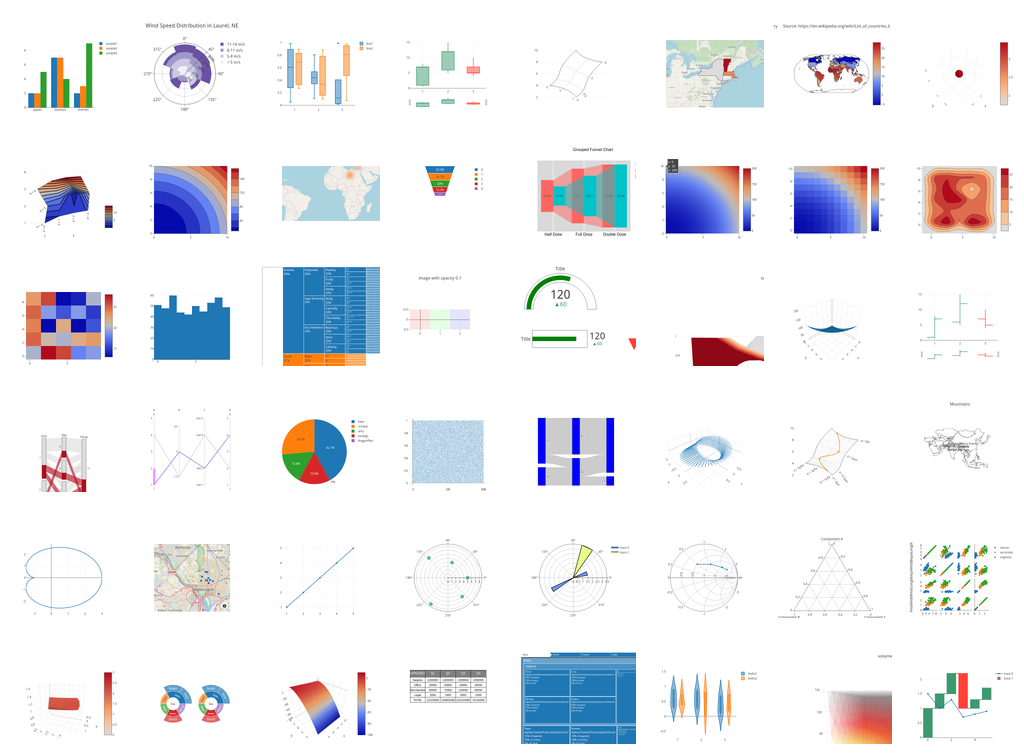packageChart::Plotly;usestrict;usewarnings;useutf8;@EXPORT_OK=qw(show_plot);useJSON;useText::Template;useModule::Load;useRef::Util;useHTML::Show;useFile::ShareDir;usePath::Tiny;our$VERSION='0.042';# VERSION# ABSTRACT: Generate html/javascript charts from perl data using javascript library plotly.jssubrender_full_html {## no criticmy%params= validate(@_, {data=> {type=> ARRAYREF | OBJECT }, } );## use criticmy$data=$params{'data'};my$chart_id= create_uuid_as_string(UUID_TIME);my$html;if( Ref::Util::is_blessed_ref($data) &&$data->isa('Chart::Plotly::Plot') ) {$html= _render_html_wrap($data->html(div_id=>$chart_id) );}else{$html= _render_html_wrap( _render_cell( _process_data($data),$chart_id) );}return$html;}sub_render_html_wrap {my$body=shift;my$html_begin=<<'HTML_BEGIN';<!DOCTYPE html><head><meta charset="utf-8" /></head><body>HTML_BEGINmy$html_end=<<'HTML_END';</body></html>HTML_ENDreturn$html_begin.$body.$html_end;}sub_render_cell {my$data_string=shift();my$chart_id=shift() // create_uuid_as_string(UUID_TIME);my$layout=shift();my$config=shift();my$extra=shift() // {load_plotly_using_script_tag=> 1 };if(defined$layout) {$layout=",".$layout;}if(defined$config) {$config=",".$config;}my$load_plotly= _load_plotly( ${$extra}{'load_plotly_using_script_tag'} );my$template=<<'TEMPLATE';<div id="{$chart_id}"></div>{$load_plotly}<script>Plotly.{$plotlyjs_plot_function}(document.getElementById('{$chart_id}'),{$data} {$layout} {$config});</script>TEMPLATEmy$template_variables= {data=>$data_string,chart_id=>$chart_id,load_plotly=>$load_plotly,plotlyjs_plot_function=> plotlyjs_plot_function(),defined$layout? (layout=>$layout) : (),defined$config? (config=>$config) : (),};returnText::Template::fill_in_string($template,HASH=>$template_variables);}sub_process_data {my$data=shift;my$json_formatter= JSON->new->allow_blessed(1)->convert_blessed(1);local*PDL::TO_JSON=sub{$_[0]->unpdl };if( Ref::Util::is_blessed_ref($data) ) {my$adapter_name='Chart::Plotly::Adapter::'.ref$data;eval{load$adapter_name;my$adapter=$adapter_name->new(data=>$data);$data=$adapter->traces();};if($@) {warn'Cannot load adapter: '.$adapter_name.'. '. $@;}}my$data_string=$json_formatter->encode($data);return$data_string;}sub_load_plotly {my$how_to_load=shift;if($how_to_load) {if($how_to_loadeq"1"||$how_to_loadeq'cdn') {}elsif($how_to_loadeq'embed') {my$minified_plotly= File::ShareDir::dist_file('Chart-Plotly','plotly.js/plotly.min.js');return'<script>'. Path::Tiny::path($minified_plotly)->slurp .'</script>';}elsif($how_to_loadeq'module_dist') {my$minified_plotly= File::ShareDir::dist_file('Chart-Plotly','plotly.js/plotly.min.js');}}else{return'';}}subhtml_plot {my@data_to_plot=@_;my$rendered_cells="";formy$data(@data_to_plot) {my$id= create_uuid_as_string(UUID_TIME);if( Ref::Util::is_blessed_ref($data) &&$data->isa('Chart::Plotly::Plot') ) {$rendered_cells.=$data->html(div_id=>$id);}else{$rendered_cells.= _render_cell( _process_data($data),$id);}}return_render_html_wrap($rendered_cells);}subshow_plot {HTML::Show::show( html_plot(@_) );}subplotlyjs_version {return'2.14.0';# plotlyjs_version_tag}subplotlyjs_plot_function {return'react';}subplotlyjs_plot_function_parameters {returnqw(div data layout config);}1;__END__=pod=encoding utf-8=head1 NAMEChart::Plotly - Generate html/javascript charts from perl data using javascript library plotly.js=head1 VERSIONversion 0.042=head1 SYNOPSISuse Chart::Plotly 'show_plot';my $data = { x => [ 1 .. 10 ],mode => 'markers',type => 'scatter'};$data->{'y'} = [ map { rand 10 } @{ $data->{'x'} } ];show_plot([$data]);use aliased 'Chart::Plotly::Trace::Scattergl';my $big_array = [ 1 .. 10000 ];my $scattergl = Scattergl->new( x => $big_array, y => [ map { rand 100 } @$big_array ] );show_plot([$scattergl]);use Chart::Plotly qw(show_plot);use PDL;use aliased 'Chart::Plotly::Trace::Surface';my $size = 25;my $x = ( xvals zeroes $size+ 1, $size + 1 ) / $size;my $y = ( yvals zeroes $size+ 1, $size + 1 ) / $size;my $z = 0.5 + 0.5 * ( sin( $x * 6.3 ) * sin( $y * 6.3 ) )**3; # Bumpsmy $surface = Surface->new( x => $x, y => $y, z => $z );show_plot([$surface]);use PDL::Math;my $bessel_size = 50;my $bessel = Surface->new(x => xvals($bessel_size),y => xvals($bessel_size),z => bessj0( rvals( zeroes( $bessel_size, $bessel_size ) ) / 2 ));show_plot([$bessel]);=head1 DESCRIPTIONGenerate html/javascript charts from perl data using javascript library plotly.js. The resultis a file that you could see in your favourite browser.=for markdown [](https://travis-ci.org/pablrod/p5-Chart-Plotly)[](https://ci.appveyor.com/project/pablrod/p5-chart-plotly/branch/master)Example screenshot of plot generated with examples/anscombe.pl:=for HTML <p><img src="https://raw.githubusercontent.com/pablrod/p5-Chart-Plotly/master/examples/anscombe.png" alt="Anscombe's quartet plotted with plotly"></p>=for markdown Example screenshot of plots generated with examples/traces/*.pl:=for HTML <p><img src="https://raw.githubusercontent.com/pablrod/p5-Chart-Plotly/master/examples/montage_all_traces.png" alt="Montage of all examples"></p>=for markdown The API is subject to changes.=head1 FUNCTIONS=head2 render_full_html=head3 Parameters=over=item * data:Data to be represented. It could be:=over=item Perl data structure of the json expected by plotly.js: L<http://plot.ly/javascript/reference/> (this data would be serialized to JSON)=item Array ref of objects of type Chart::Plotly::Trace::*=item Anything that could be serialized to JSON with the json expected by plotly.js=item Object that could be adapted using Chart::Plotly::Adapter::*=back=back=head2 html_plotReturn the html for the plot or plots=head3 ParametersData to be represented. The format is the same as the parameter data in render_full_html. Accepts multiple traces/plots/objects.=head2 show_plotOpens the plot or plots in a browser locally=head3 ParametersData to be represented. The format is the same as the parameter data in render_full_html. Accepts multiple traces/plots/objects.=head2 plotlyjs_versionReturns the version of plotly.js using in this version of the perl module as a string=head2 plotlyjs_plot_functionReturns the name of function of plotly.js used in this version of the perl module to draw plots=head2 plotlyjs_plot_function_parametersReturns the function parameters of the function of plotly.js used in this version of the perl module to draw plots as a list of strings=head1 BUGSPlease report any bugs or feature requests via github: L<https://github.com/pablrod/p5-Chart-Plotly/issues>=head1 DISCLAIMERThis is an unofficial Plotly Perl module. Currently I'm not affiliated in any way with Plotly.But I think plotly.js is a great library and I want to use it with perl.If you like plotly.js please consider supporting them purchasing a pro subscription: L<https://plot.ly/products/cloud/>=head1 AUTHORPablo Rodríguez González <pablo.rodriguez.gonzalez@gmail.com>=head1 COPYRIGHT AND LICENSEThis software is Copyright (c) 2022 by Pablo Rodríguez González.This is free software, licensed under:The MIT (X11) License=head1 CONTRIBUTORS=for stopwords Roy Storey stphnlyd weatherwax=over 4=item *Roy Storey <kiwiroy@users.noreply.github.com>=item *stphnlyd <stephanloyd9@gmail.com>=item *weatherwax <s.g.lobo@hotmail.com>=back=cut